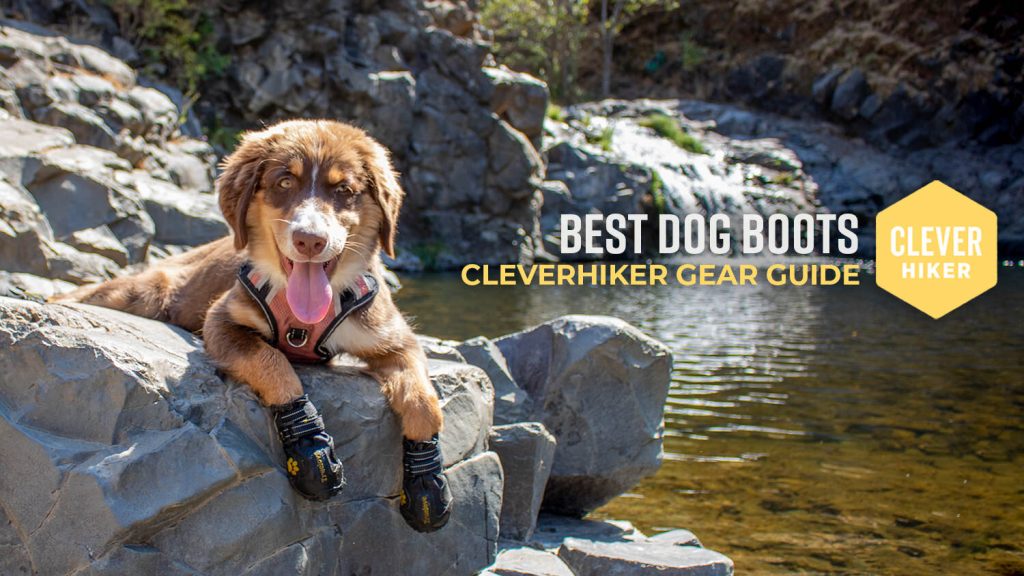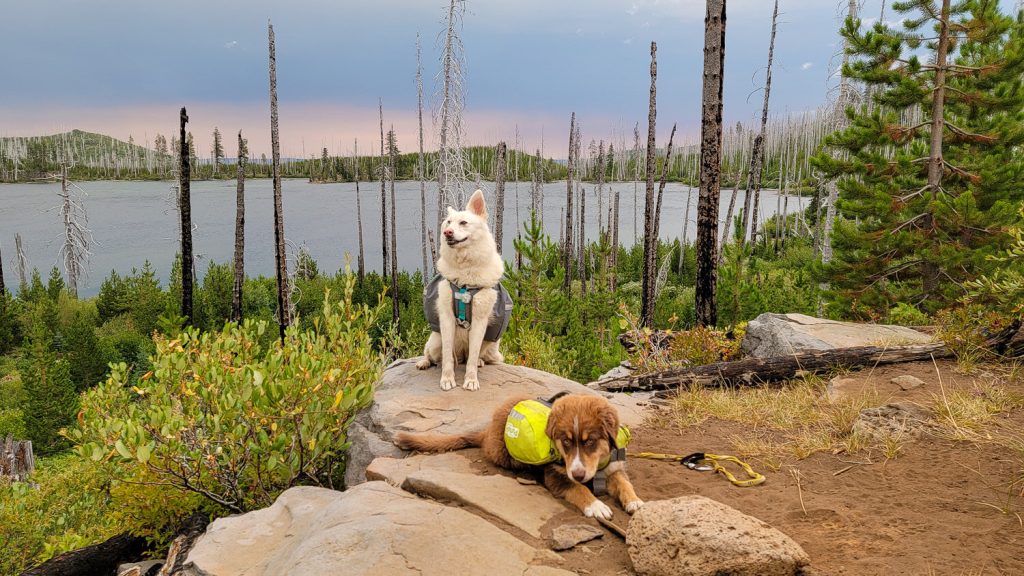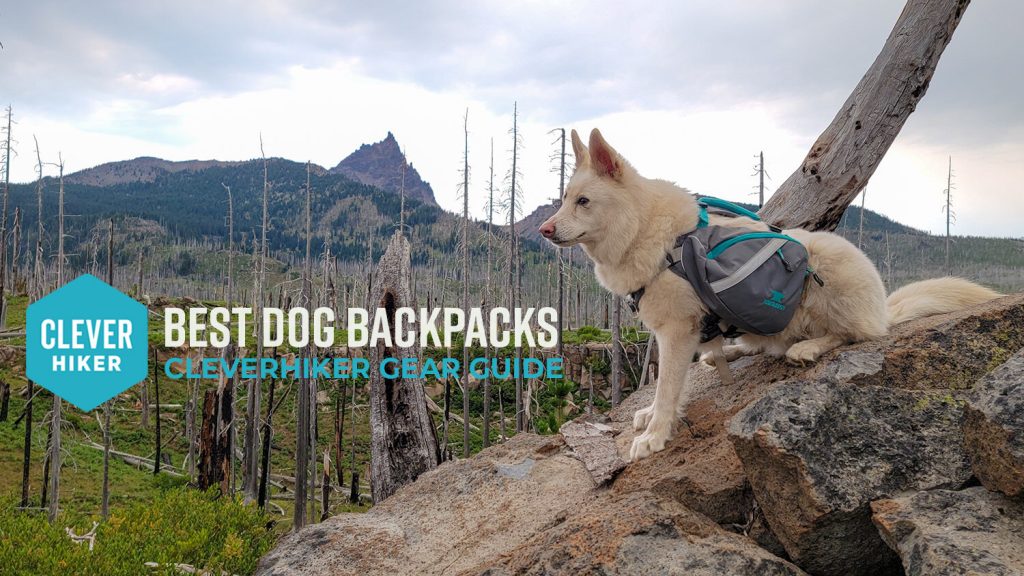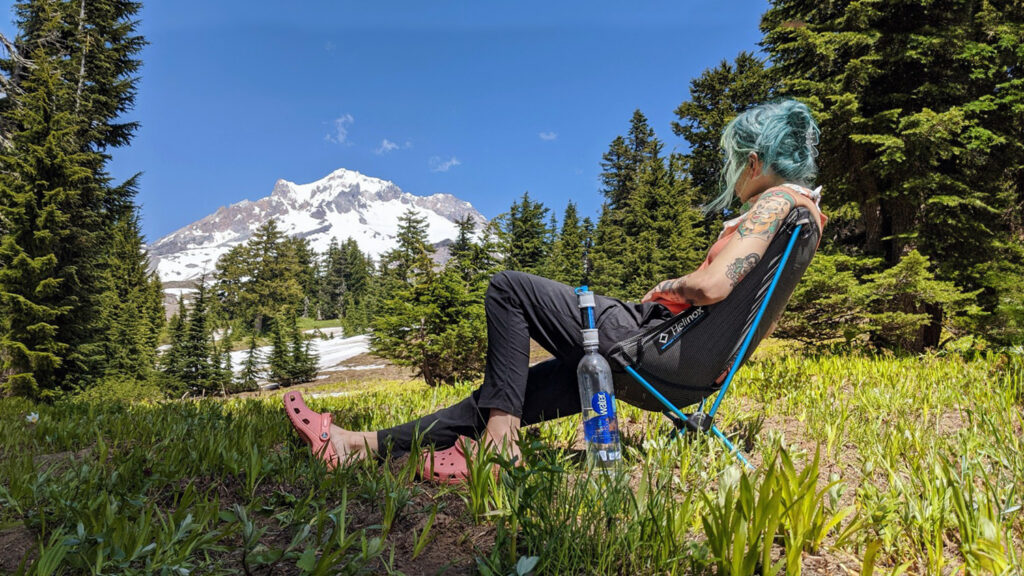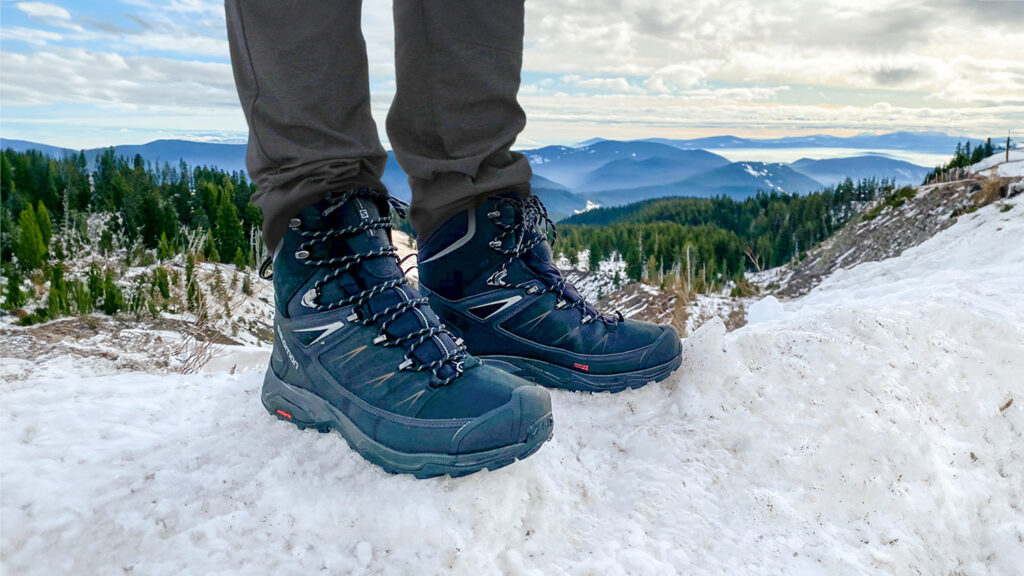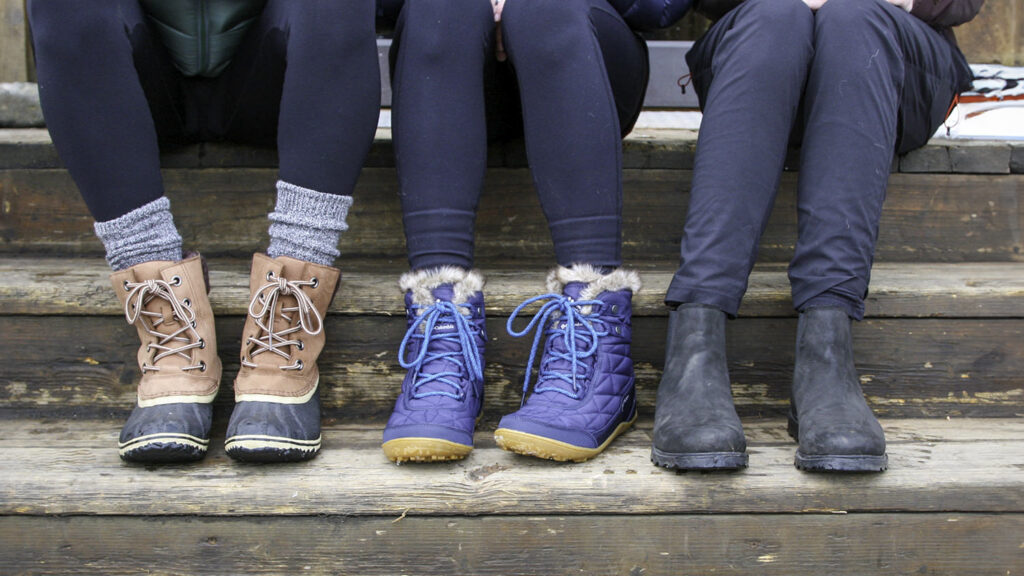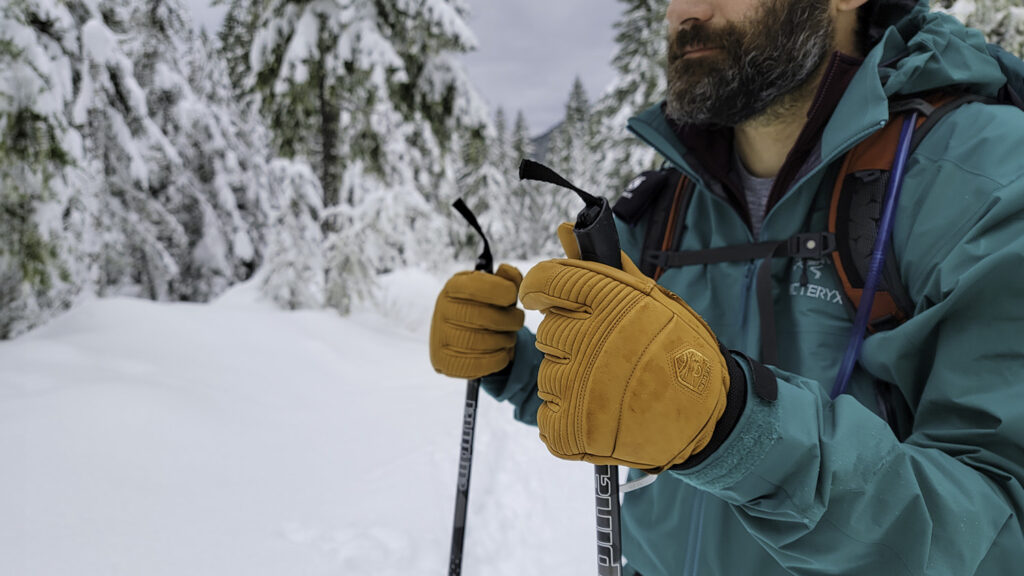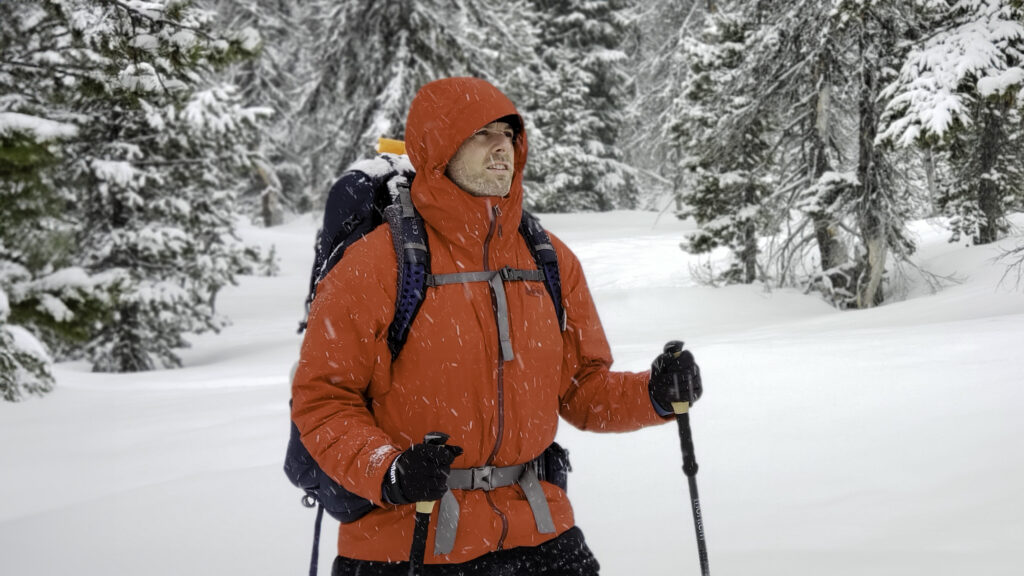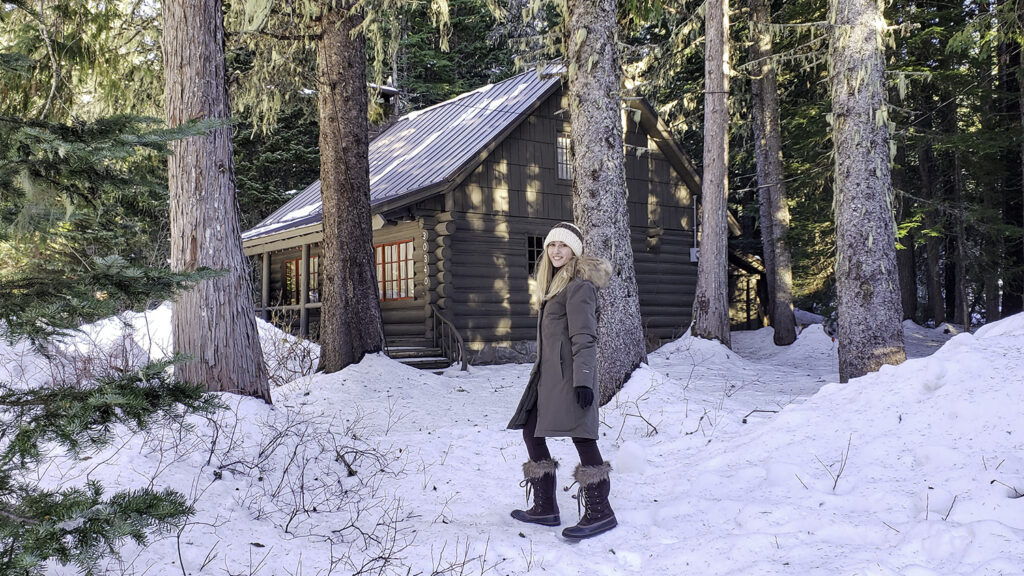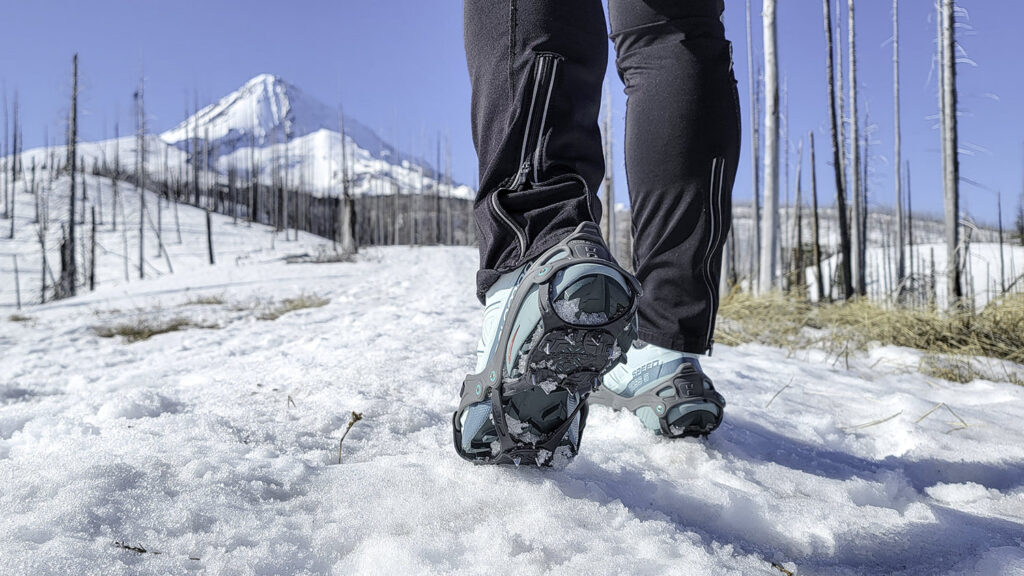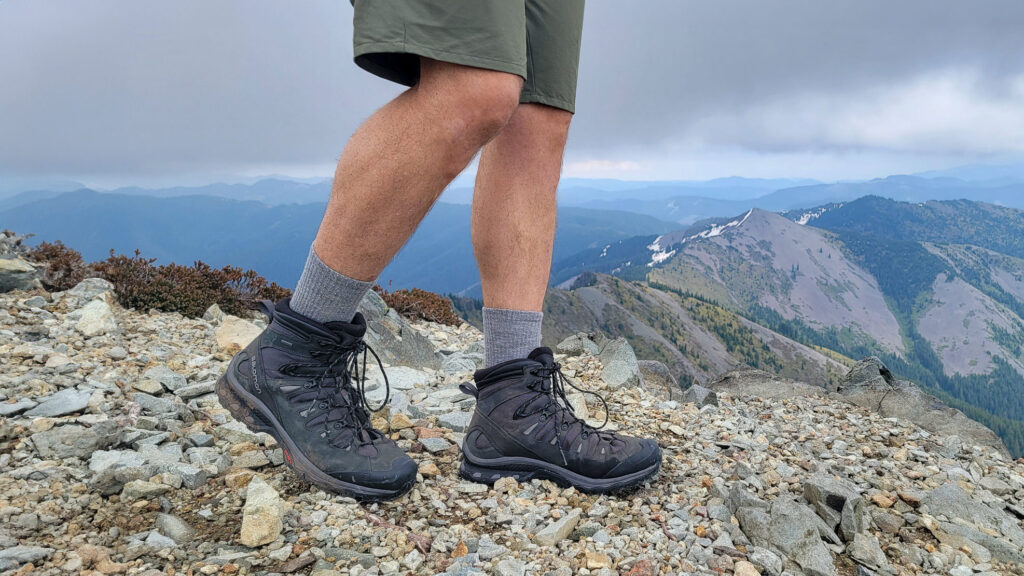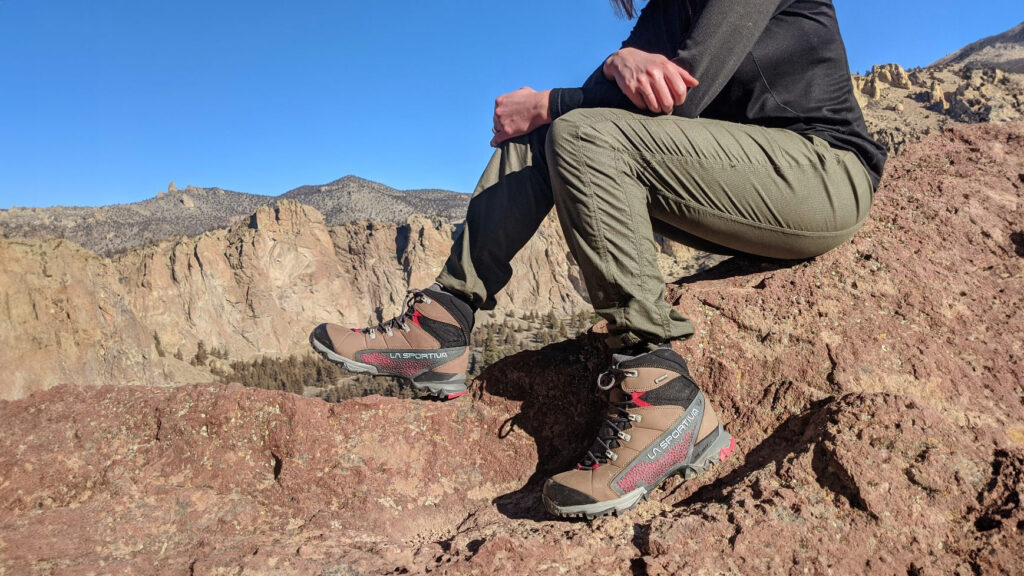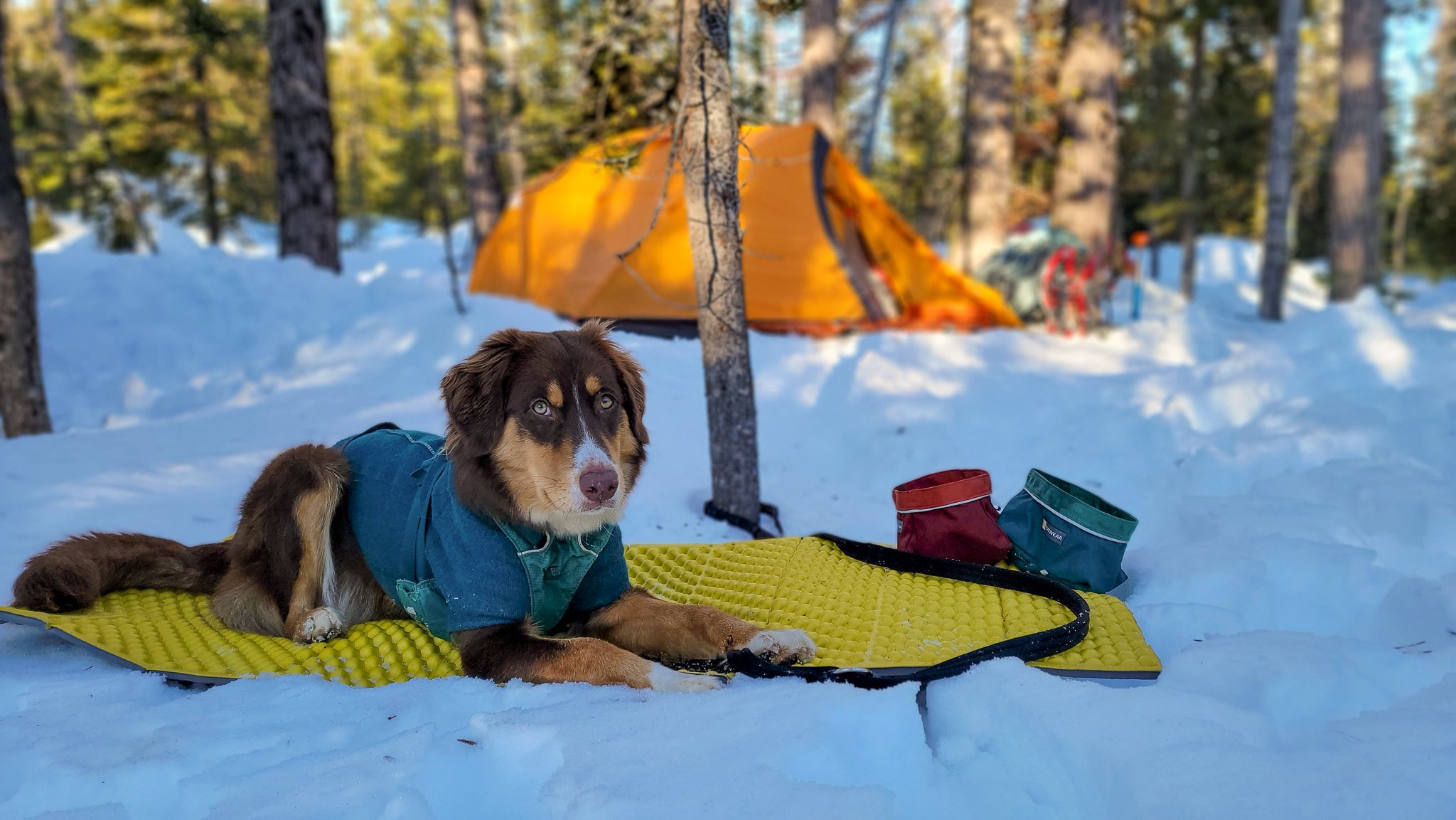
Taking your dog for a rainy hike or a jaunt in the snow is incredibly fun and a great way to keep them active during the winter. But adventuring with your pup in cold, wet conditions comes with its own specific challenges. Here are a few tricks we’ve learned to keep our dogs comfortable, happy, and healthy on winter hikes.
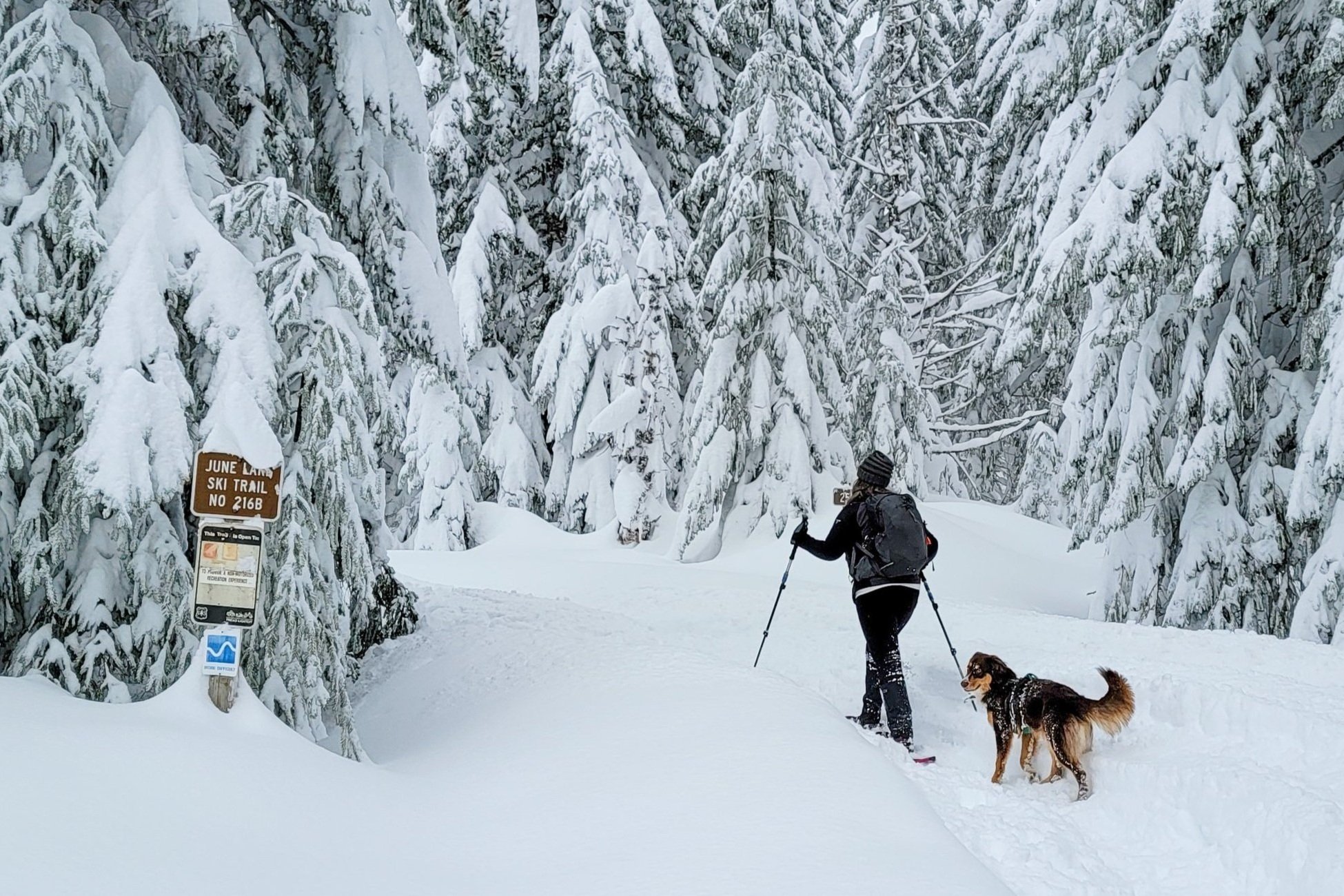
Quick Recommendations
Here’s a quick overview of our favorite dog gear for winter if you’re in a hurry. You can use this as a checklist, though many of the items below are optional. We’ll also give more info about why we recommend these products below.
For the trail:
- Dog boots / Musher’s Secret Wax – to protect the paws
- Coconut oil cooking spray / snow protector suit – put on pre-trip to avoid snowball accumulation
- Food +
- Treats + treat pouch – to fuel your dog’s body and drive to cooperate
- Poop bags + gallon ziplock or
- Dog backpack – so your dog can carry their own stuff on trips
- Collar/harness – for hiking or pulling depending on activity
- Collar light – so you and cars can see your dog after sunset
- Leash or towline + human belt (for canicross/skijoring)
In the car:
- Quick-dry towel – to dry your dog after wet activities
- Blanket – to keep your dog cozy post hike
- Dog bathrobe – to keep your damp dog warm in the car
- Dog car hammock / seat cover – to keep your dog safe and your car clean
- Dog food & airtight container – to keep in the car for meals on the go/just in case
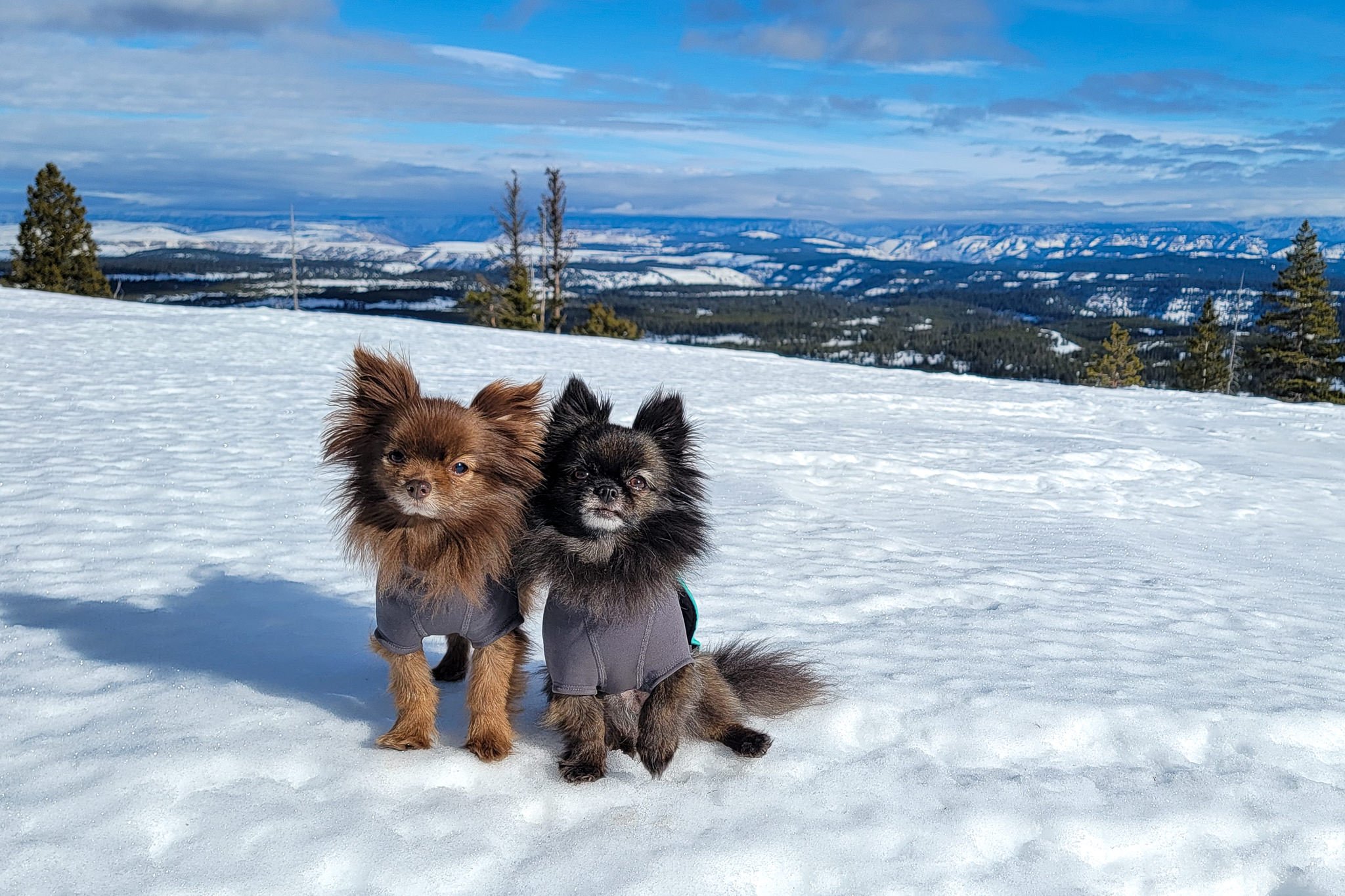
10 Tips For Hiking With Your Dog In Winter
Temperature Tolerance
Factors like breed, size, age, fur type, activity level, and metabolism determine how well your dog will fare in low temperatures. Monitor your dog in the cold close to home before taking them on any major winter trips. Watch for signs of discomfort like shivering, curling up, refusing to walk, or picking up/licking their paws. You know your dog best, so use your best judgment to decide when it’s appropriate to take them on a trip and when it’s best to leave them at home. Most healthy, active dogs can tolerate temperatures down to freezing, but some might benefit from a
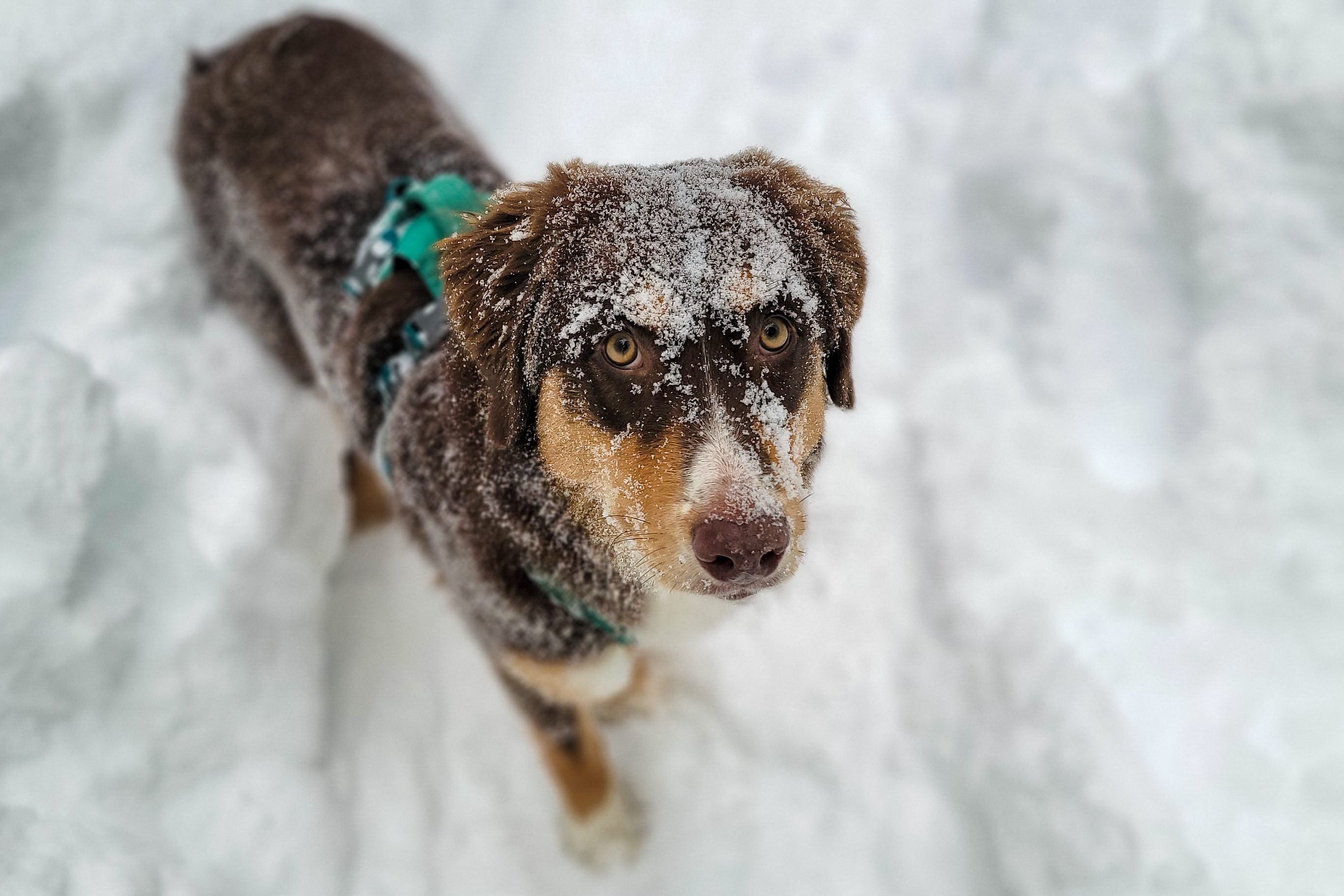
Stay Flexible
It’s critical to be open to changing plans when adventuring with dogs. If conditions are harsher than you expected, it’s ok to pivot and switch to plan B. Just like us, dogs have good days and bad days – sometimes they’ll excitedly plow through snowdrifts for hours, while other times they’ll whine before the parking lot is even out of sight. Don’t push your luck if things don’t feel safe, especially if you’re venturing more than an hour from your car. It’s better to cut a trip short and head for a more protected hike or the comfort of home than to make a mistake during the winter that could result in serious injury or even death.
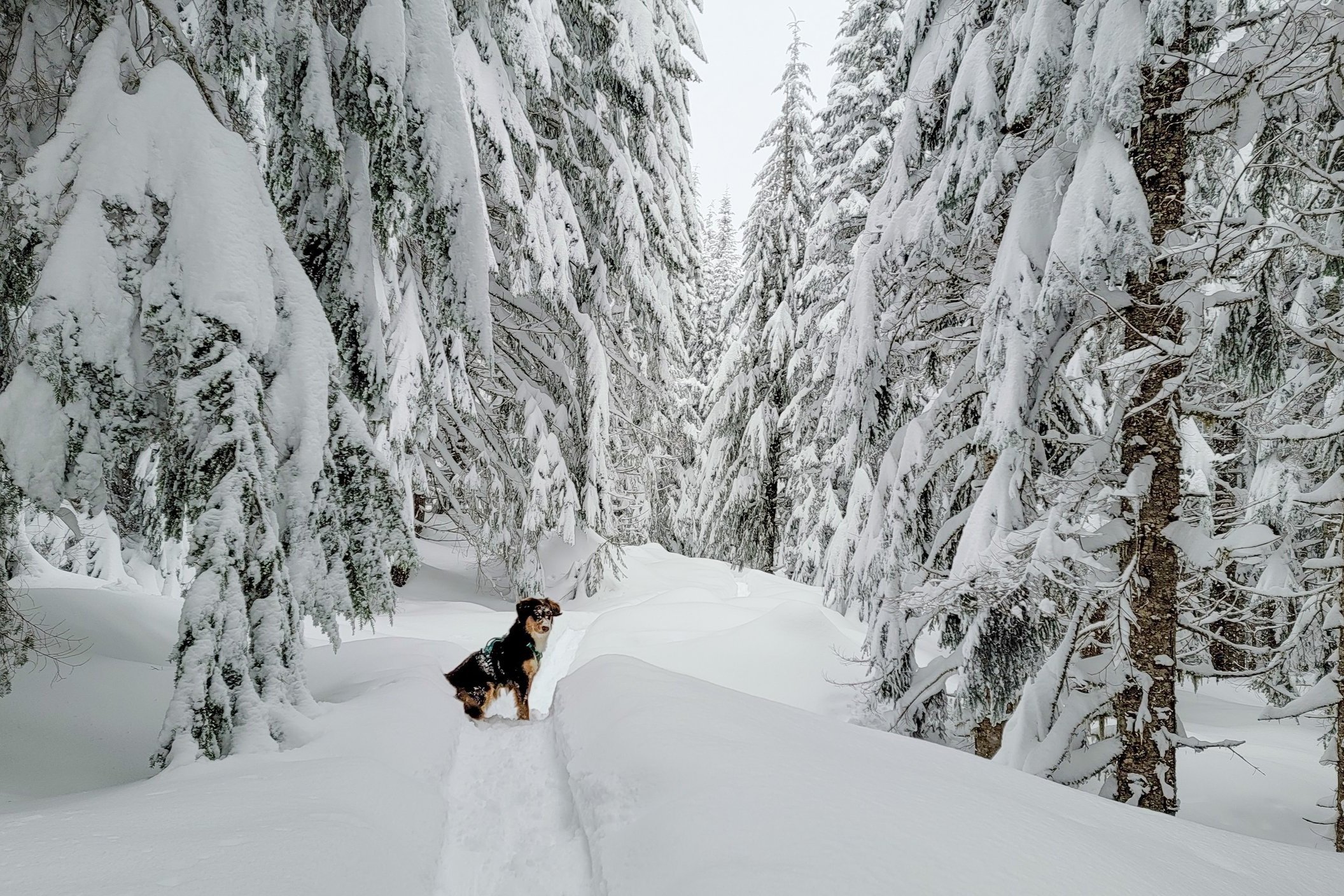
Protect the Paws
Enthusiastic dogs might seem unscathed by walking on snow or ice at first, but it’s best to bring something to put on your dog’s paws if they start showing signs of discomfort. Prolonged exposure to cold surfaces (or salts used for de-icing) can be harmful to your dog’s paw pads and can lead to cracking, blisters, and even hypothermia. Dog boots are a simple solution. Your pooch may walk funny at first, but they’ll soon forget they’re wearing them as soon as something more exciting captures their attention. If boots aren’t your dog’s jam or you’re having a hard time keeping them on your hyper friend’s feet, try Musher’s Secret Wax instead. Apply the balm generously to the paw pads and between the toes to create a protective barrier and prevent snow buildup. For best results, you should also keep the nails and paw fur trimmed short.
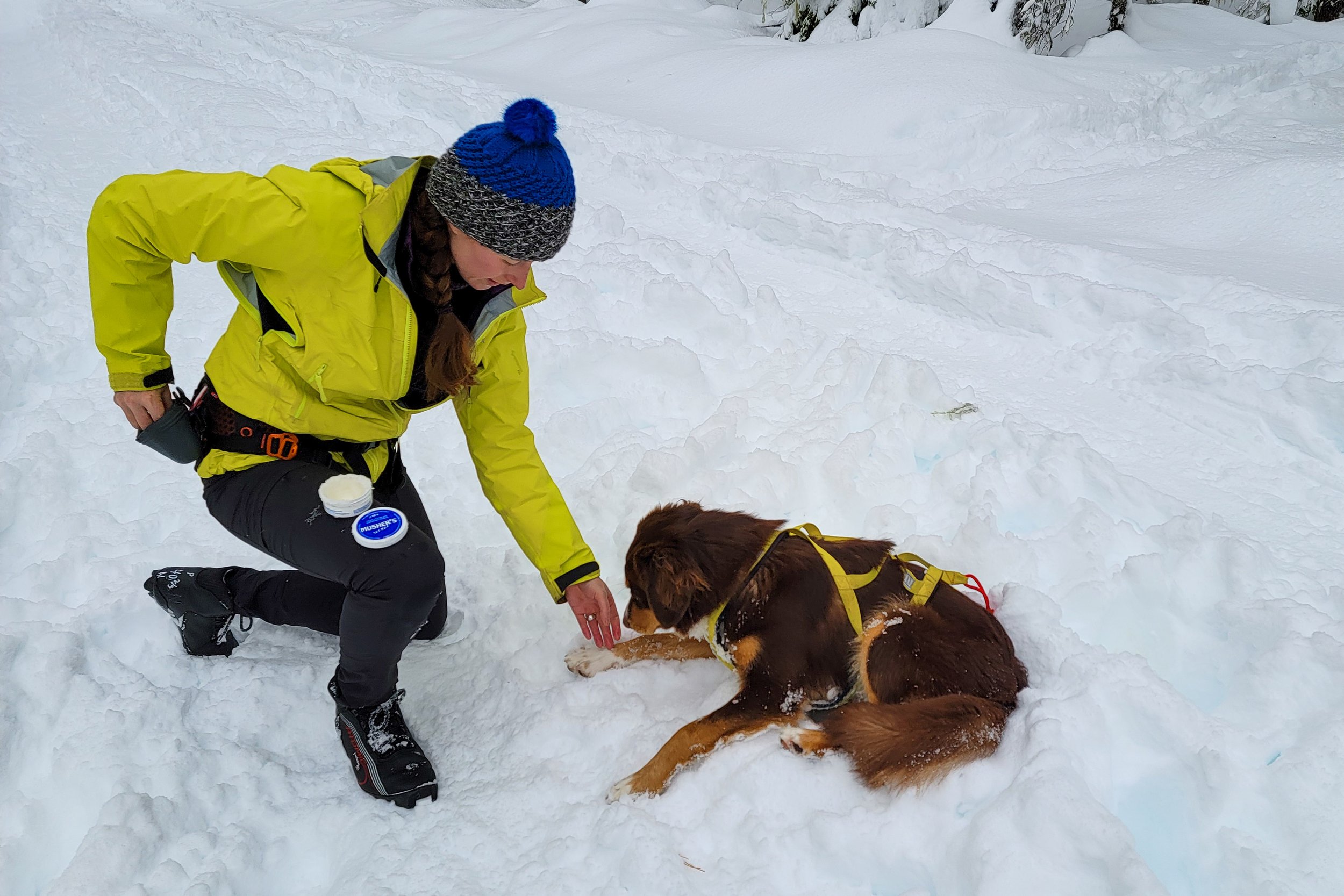
Avoid Snowballs
Some dogs – particularly those with longer or textured fur – are susceptible to snow buildup or ‘snowballs’, which cling to their underside, pits, and paws. As these snowballs grow in size, they get heavy and may pull on the dog’s sensitive skin. Packed snow on your pup’s body will make them cold quickly, and ice balls that get lodged between their toes can cause splitting. To prevent this, stop occasionally and check your dog. Crush large snowballs between your fingers to avoid painful hair-pulling, and massage the fur gently to remove as much snow as you can. To avoid the dreaded snowballs you may want to try pre-treating trouble areas by making the fur slippery with coconut oil cooking spray. Just be sure to test a small area before you go all out to make sure your dog isn’t allergic. If snowballs are an issue for your dog, a suit with belly and leg coverage is a great option.
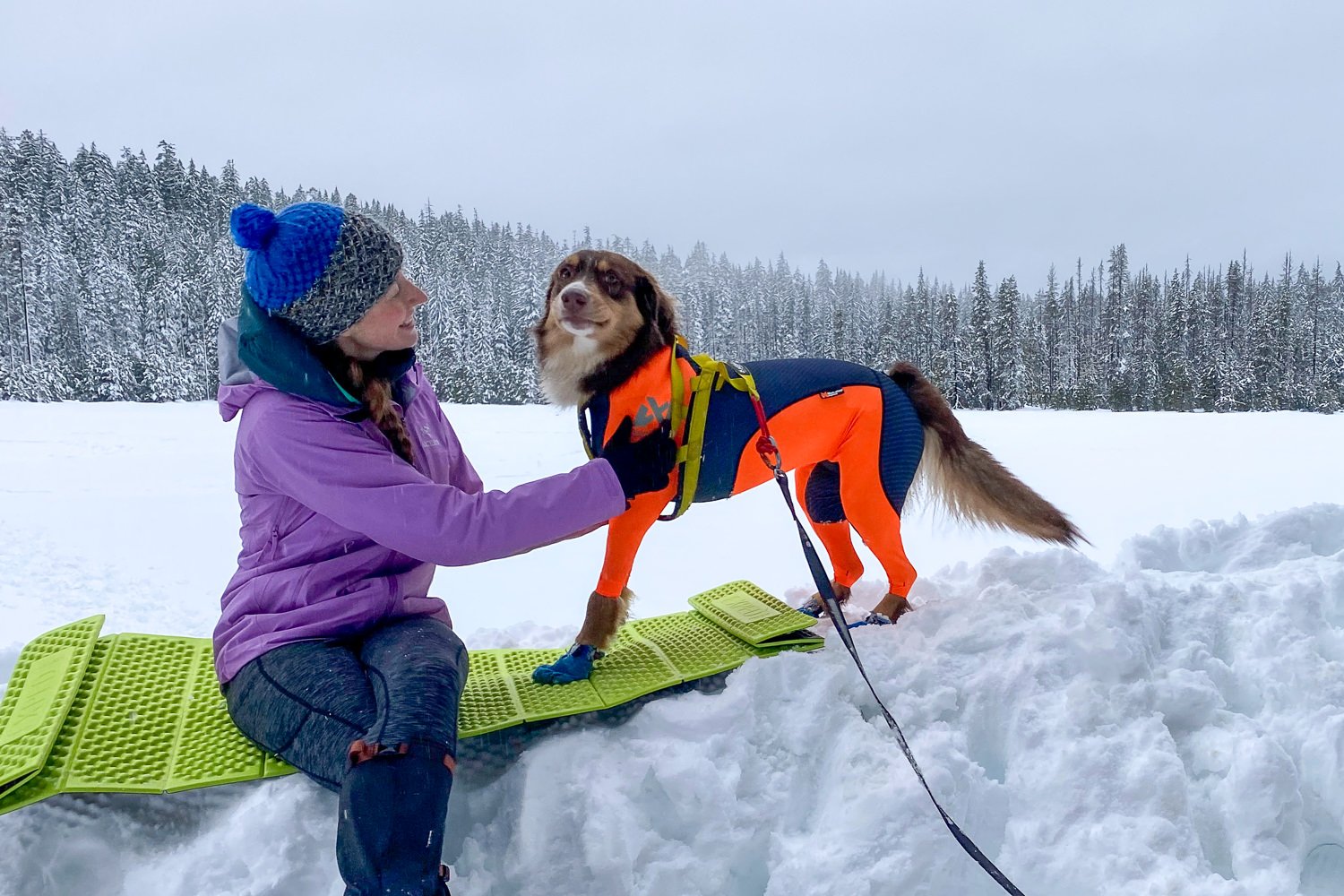
Avoid Winter Hazards
It’s best to get familiar with the lay of the land before you take your dog on a winter hike. That way, you’ll know if there are steep drop-offs, frozen lakes, or potential avalanche terrain before you let your dog off leash (where allowed). If you’re adventuring in a new place with your pup, keep them on a leash or be 100% confident that they’ll follow voice commands for safety. Know the red flags of avalanche danger and avoid venturing out on frozen lakes unless you’re very experienced assessing ice. Pockets of loose snow around trees (tree wells) could potentially suffocate a dog if they get stuck in one. To mitigate this risk, keep your dog on a leash or within sight if there’s been heavy, fresh snowfall and there are large trees around, so you can quickly dig them out in an emergency.
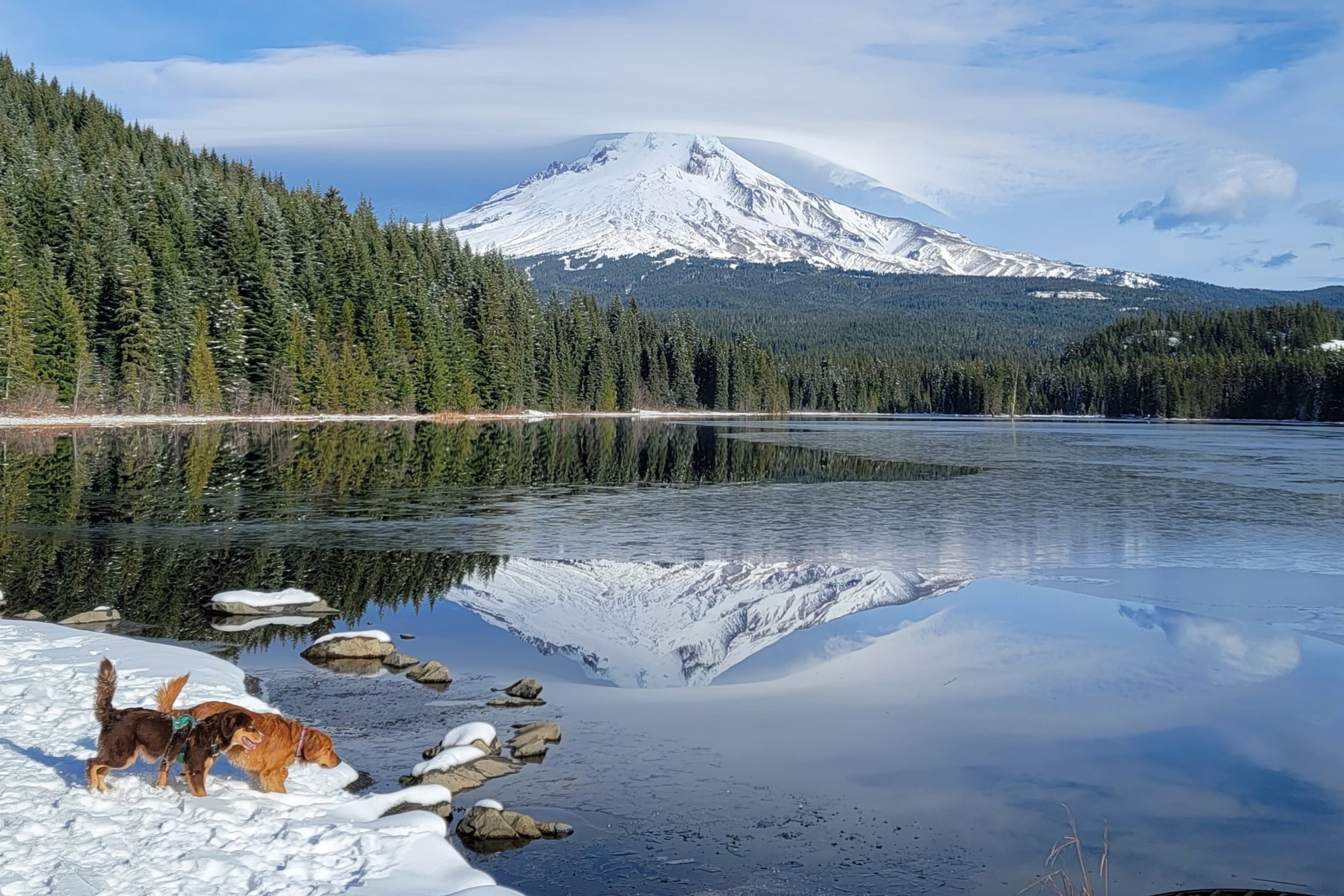
Water
Whether you’re hiking, snowshoeing, or cross-country skiing with your dog, they’re bound to be excited and working hard to keep up with you. Make sure your canine companion stays hydrated by offering them water throughout the trip. If you’re really going for it, you can even share a small amount of electrolyte drink mix with your dog. A good rule of thumb is to offer them a drink of water whenever you take one. We love these collapsible dog bowls because they’re super lightweight, packable, and affordable. If you’re a hydration pack fan, you may also be able to train your dog to drink from it, by leaning down and spraying a small stream of water at an angle.
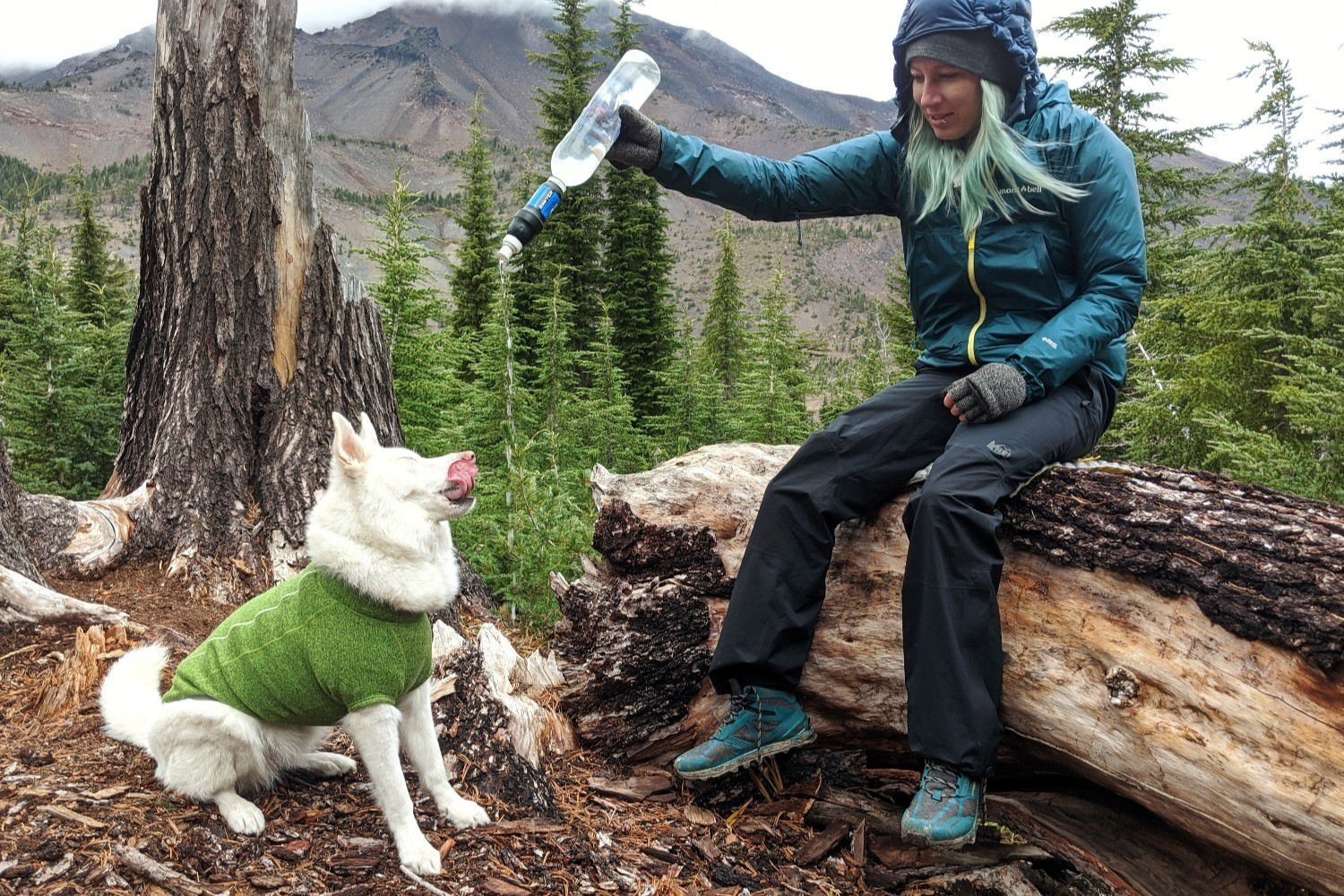
Food & Treats
Your body burns more calories to stay warm in the winter, and the same goes for dogs. Winter sports are generally considered vigorous exercise, so be sure to bring plenty of snacks to keep both you and your pup consistently fueled. Bring your airtight container of our dog’s food in the car during the winter just in case. Load up with plenty of training treats to reward them for staying close and engaged with you throughout the trip. This treat pouch makes it easy to dish out anything from dry kibble to fresh meat on the go.
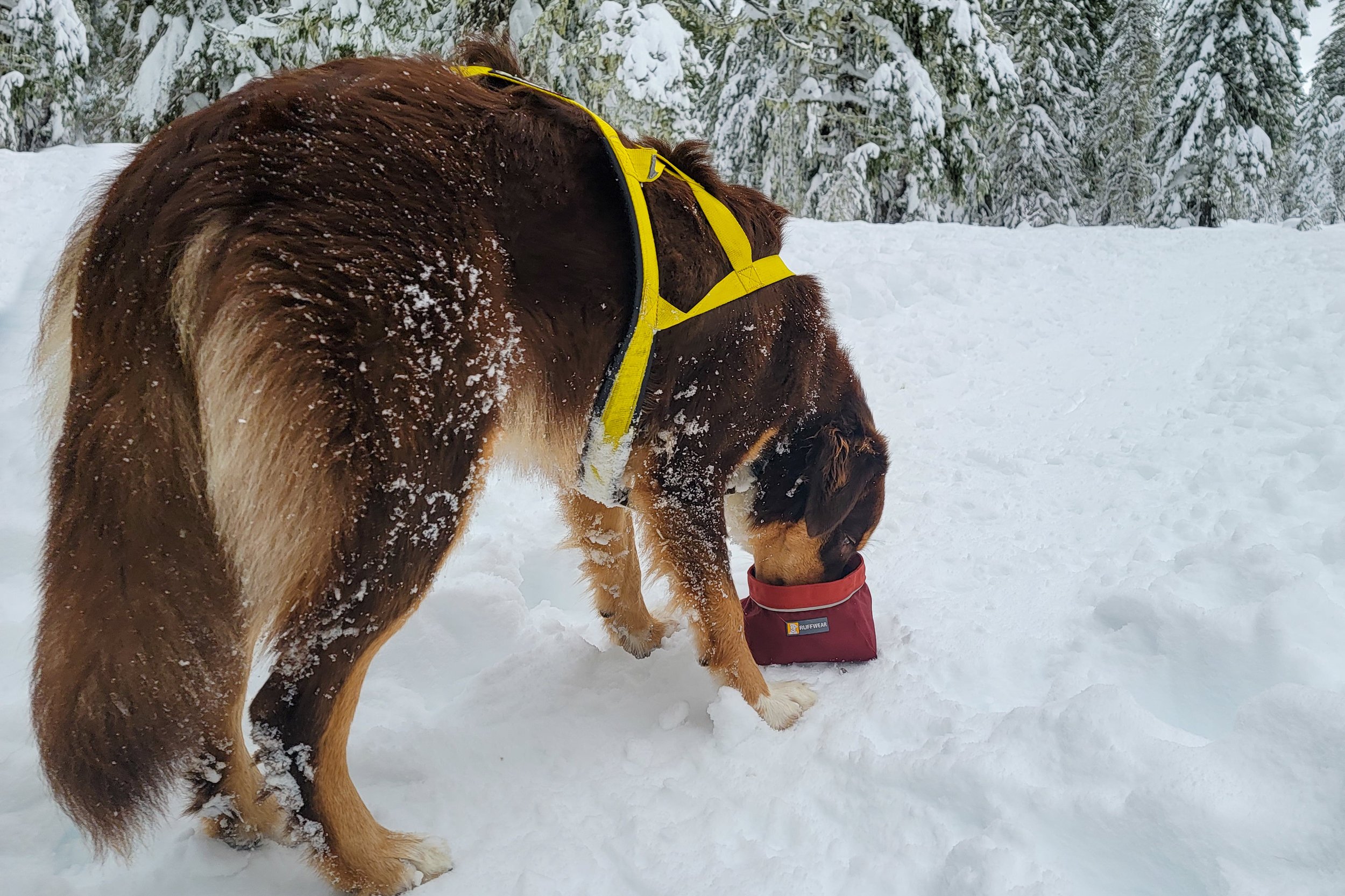
Sit Pad
If it’s cold out, your body temperature will drop quickly when you stop moving. It’s a good idea to pack a sit pad (depending on the size of your dog) to insulate you and your dog from the ground when you take breaks. A foam pad is a bit bulky, but they’re lightweight and easy to strap to your pack. You’ll be glad to have it should an emergency arise, especially if there’s snow on the ground.
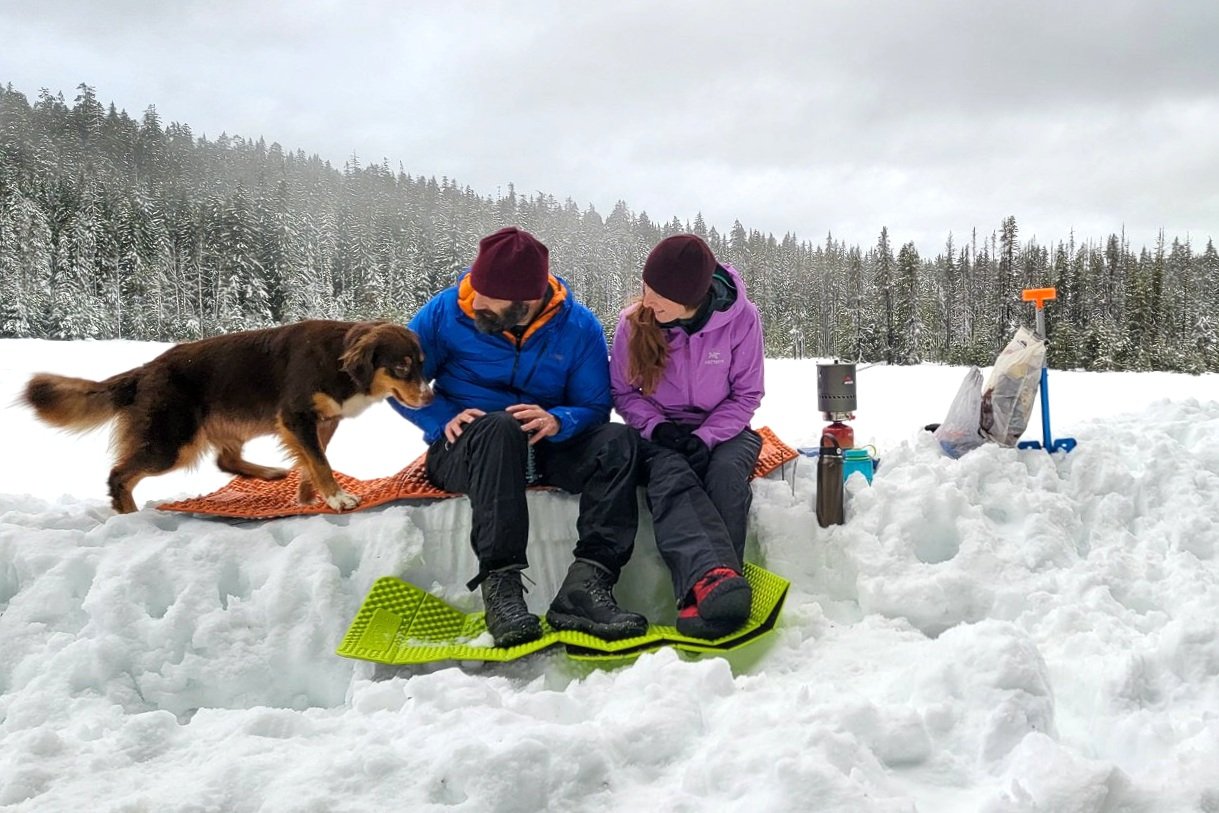
Post-Hike Protocol
No matter how cold-tolerant your pup is, they’re likely to get chilly when they stop moving – especially when wet. We keep a quick-dry towel in the car to dry our dog thoroughly during the fall and winter months. Take off wet harnesses, jackets, or booties, and pay particular attention to drying the legs, paws, belly, and groin as these areas tend to be the most saturated and take the longest to dry. We always offer our dog a drink to make sure she’s well-hydrated when we get to the car and a treat to reinforce good behavior and cooperation with our post-hike routine.
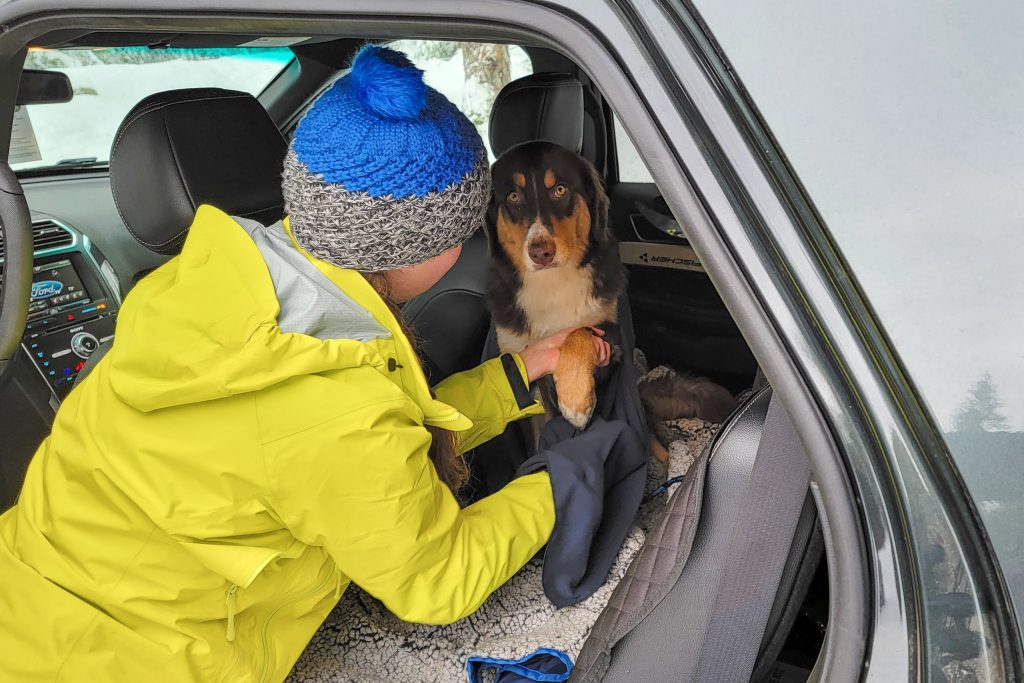
The Car
It’s a good idea to keep a blanket in the car so your dog has a cozy place to curl up and sleep after intense exercise – we’re big fans of this waterproof sherpa fleece one from Oceas. If the trip was particularly wet or very cold, you can put on a dog bathrobe to help dry your pooch even more and keep them from getting cold when damp. This can be particularly helpful if you plan to leave your pup in the car while you go out for a meal on the way home (assuming temperatures aren’t too extreme). Lastly, we love our Dog Car Hammock. It keeps your dog safe and contained in the back seat and protects the seats themselves from mud and scratches. Just toss it in the washing machine when it needs a refresh. We can honestly say it’s one of the best purchases we’ve ever made as dog owners living an active outdoor lifestyle.
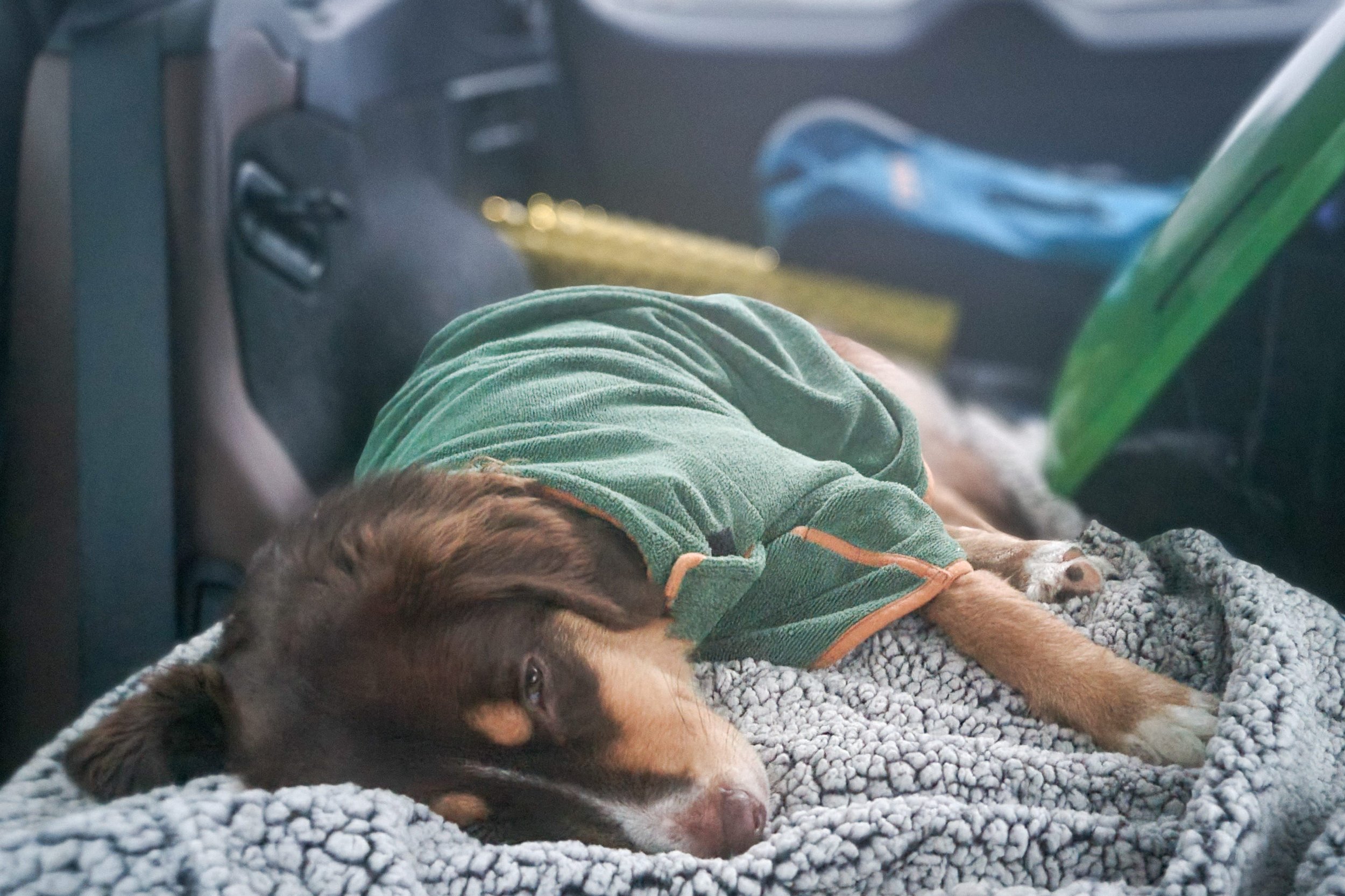
Doo-Doo Bags
It’s always important to clean up after your dog by picking up waste, but especially so when it’s raining or snowing to keep contaminants from washing into our water systems. If you’re carrying a backpack, a gallon ziplock or poop bags for more than a short distance. If your dog carries a backpack, you could also line one of the pockets with a plastic bag and have them carry out their own poop bags.
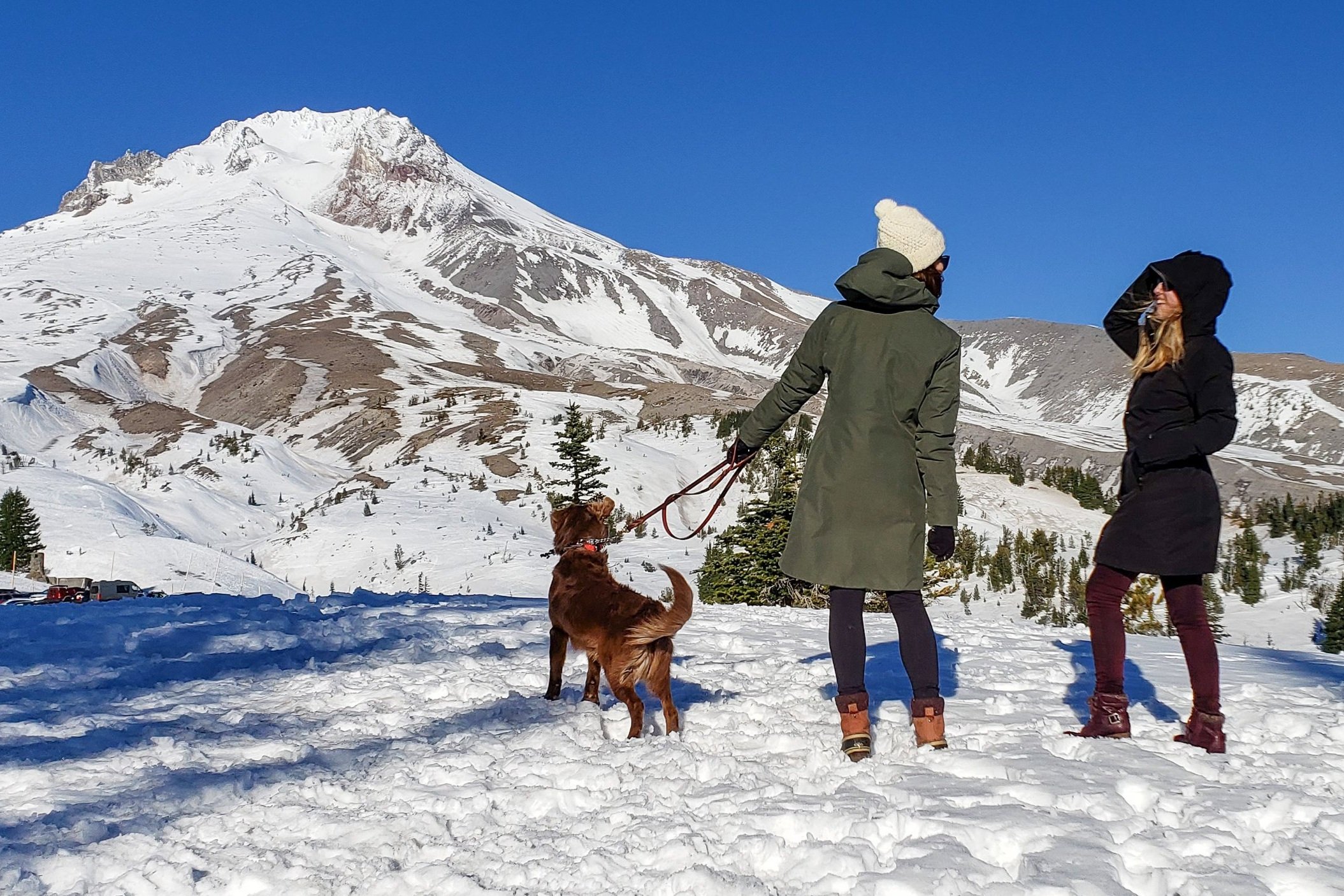
Snow dogs are the best! And as the saying goes, a tired dog is a good dog, so get out there and have some winter fun with your furry friends! We hope these tips help make winter recreation more fun for your dog as well as easier for caring dog owners like yourself. If you liked this article, you’ll probably also enjoy our 14 Tips for Hiking and Backpacking with a Dog post.



